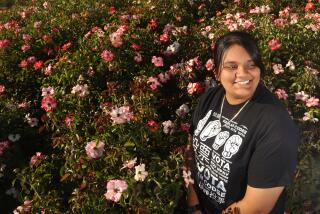A plastics teaching moment
My daughter and I recently made the annual back-to-school pilgrimage to the local big-box office store, and I am appalled. For me, the leathery smell of new shoes stirs sweet pangs marking those precious last days of summer; for my children, it likely will be the smell of vinyl and assorted plastics.
As a child of the 1960s, when plastics had yet to touch every aspect of our lives, my pencils and rulers were made of wood; my binders, cardboard and fabric; my book bag, canvas, and back-to-school shopping wasn’t a major industry, let alone a “season.”
As a toxicologist who has spent much of the last year studying the world’s overabundance of plastics and their associated toxicities and as a consumer who carries cloth bags, avoids over-packaged lunch items and diligently recycles -- though admittedly I am not a purist when it comes to plastic -- this year’s shopping left me feeling particularly hypocritical.
We entered the store armed with “the list” sent home by her teachers. We left with an armful of polyvinyl chloride (PVC), polystyrene, polypropylene, polyethylene, all neatly packaged in yet more polystyrene and PVC -- and very little of it readily recyclable. The store’s hundreds of brightly colored disposable plastic pens certainly are not recyclable. Not only are products often a combination of plastics not easily separated (polystyrene, thermoplastic elastomer and polycarbonate, for example), recycling is seldom feasible because there’s an insufficient market for the materials.
By some estimates, hundreds of millions if not billions of disposable pens are sold in the U.S. each year. Once disposed of or lost, bits of those pens will eventually add to the Earth’s expanding “plastic layer,” a marker of our penchant for the disposable rather than the reusable.
Then there is the scourge of the three-ring binder. Last year’s binders were orange and yellow. This year, according to “the list,” they must be purple, black, green and red -- a color for each subject. Although binders in good condition can be reused, eventually they will break and join their plastic companions in the waste pile.
If the big-box stores can collect e-waste and printer cartridges, you’d think they could collect and encourage reuse and recycling of school and office supplies. Apparently once all that plastic leaves the door, it’s our problem, not theirs. So much for the concept of “extended producer responsibility.” With nearly 56 million K-12 students returning to school, those new plastic binders, lunch boxes, pens, rulers and pencil sharpeners add up to a big problem.
It is a problem, though, that a little creativity could turn into a sobering educational opportunity. Just as students now study the water cycle, what if they studied the life cycle of their pen or their PVC notebook? They’d learn that the production of PVC may contaminate the air of local neighborhoods with vinyl chloride, a known carcinogen, and may be associated with increased dioxin concentrations in local residents. Or that some portion of the plastics in their school supplies could end up circulating for decades in remote ocean regions. They’d learn that some marine birds have been found with guts full of colorful plastic bits. Or that plastic could be a good thing if we reused or recycled.
Of course, school supplies are only a drop in the plastic bucket -- a small fraction of the more than 100 billion pounds of plastic resin reportedly produced by U.S. industries. This is 100 billion pounds of substances resistant to degradation. Some of the substances, as they break into smaller pieces, will release their chemical building blocks and additives such as heavy metals and phthalates -- several of which interfere with endocrine function -- into the environment.
According to a 2008 Environmental Protection Agency report, Americans discarded 30 million tons of plastic in 2007 -- 12% of our municipal solid waste -- with only 2.1 million tons of it recycled. The rest is sent to landfills, burned in incinerators, washed up on beaches or left swirling in the huge trash gyre in the Pacific. In the 1960s, less than 1% of our waste was plastic.
But there’s hope. Just as plastic is a man-made modern miracle of chemical engineering, cleaning up after the plastic mess could be this century’s miracle. For some products, closed-loop processing -- fully recyclable carpets, for example -- reduces resource use and waste. For school supplies that can’t be easily recycled, what if kids were challenged (or rewarded) to keep their plastic binders, rulers and pencil sharpeners in good shape so they can be reused? For items that don’t last, perhaps a collection box piled high and then sent to key politicians or back to the store, sending a message to industry.
And better yet, what if teachers -- originators of “the list” -- urged students to seek out recycled, recyclable or plastic-free supplies? At the very least, let’s teach them to slow the growth of the plastic layer.
More to Read
Inside the business of entertainment
The Wide Shot brings you news, analysis and insights on everything from streaming wars to production — and what it all means for the future.
You may occasionally receive promotional content from the Los Angeles Times.










